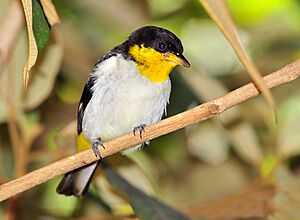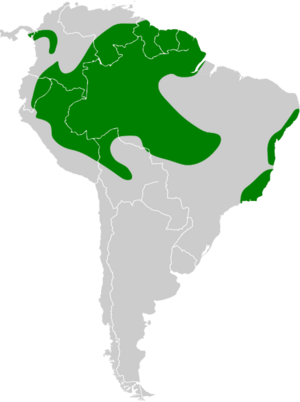Yellow-backed tanager facts for kids
Quick facts for kids Yellow-backed tanager |
|
|---|---|
 |
|
| Hemithraupis flavicollis insignis | |
| Conservation status | |
| Scientific classification | |
| Genus: |
Hemithraupis
|
| Species: |
flavicollis
|
 |
|
| Synonyms | |
|
Nemosia flavicollis |
|
The yellow-backed tanager (Hemithraupis flavicollis) is a colorful bird that belongs to the tanager family, called Thraupidae. These birds are known for their bright feathers! You can find them living in the warm, tropical forests of South America. Their home includes countries like Bolivia, Brazil, Colombia, Ecuador, French Guiana, Guyana, Peru, and Suriname. They also live in a small part of Central America, in eastern Panama. These tanagers prefer subtropical or tropical moist lowland forests, which are forests with lots of rain and warm weather. They can even live in areas where the forest has changed a lot.
What's in a Name?
The name Hemithraupis comes from ancient Greek words. Hēmi means "half" or "small," and thraupis was a name for a small bird. Scientists often use thraupis when talking about tanagers. The second part of its name, flavicollis, comes from Latin. It means "yellow-backed," which perfectly describes this bird's bright yellow back!
How Scientists Group Birds
The yellow-backed tanager was first described in 1818 by a scientist named Louis Pierre Vieillot. He first placed it in a group called Nemosia. Later, it was moved to its current group, Hemithraupis.
Scientists have found that there are actually 11 different types, or subspecies, of the yellow-backed tanager. These subspecies look very similar but might have slight differences in their colors or where they live. For example, some live in Suriname and northern Brazil, while others are found in Panama or different parts of Colombia and Peru.
What Does It Look Like?
The yellow-backed tanager is a fairly small bird. It weighs about 12.9 grams, which is less than a handful of coins! Its tail is about 5 centimeters long.
Like many birds, male and female yellow-backed tanagers look different. This is called Sexual dimorphism. The males are much brighter and more colorful than the females.
- Males: Most male yellow-backed tanagers have a black head, neck, wings, and tail. Their throat, back, and a part under their tail are bright yellow. Their chest and belly are white.
- Females: Females are also pretty, but their colors are softer. They have a bright yellow throat, chest, and rump. Their head, neck, back, belly, and tail are more of an olive-green color.
Both male and female tanagers have silvery-grey legs. Their beak has a dark upper part and a yellowish-orange lower part. The male's beak colors are usually brighter. These birds make many different sounds, including high-pitched chirps and trills. Males even make a buzzing sound when they are trying to find a mate!
How Are They Doing?
The IUCN checks on how many animals are left in the wild. They have listed the yellow-backed tanager as a species of "Least Concern." This means that there are still many of them around, and they are not in danger of disappearing right now.
Experts at BirdLife International believe there are between 5 million and 50 million yellow-backed tanagers in the world. Even though their numbers might be slowly going down, they are still quite common in the areas where they live.


